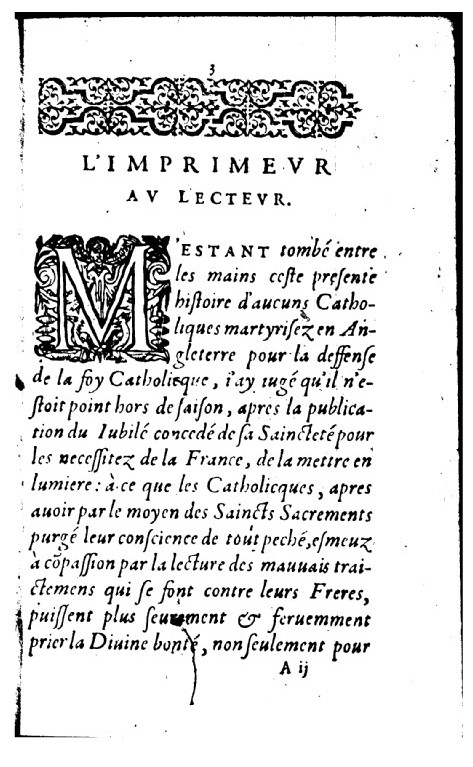At the end of the sixteenth and beginning of the seventeenth centuries, France is riven by conflicts with both political and religious motivations, known as the Wars of Religion. Wars are waged with swords but also with pens: various political or religious groups use the printing press to disseminate their ideas and plead their cause. They produce a large number of polemical texts easily identifiable by their poor quality: short format, simple presentation, recurrent typos, extremely rapid production process, very low price. The zealous Catholics (who oppose both Protestants and moderate Catholics) represent an example of such a group, and have received very little research attention, despite having produced numerous and very instructive polemical prints. A peak can clearly be observed from 1585 to 1594, when zealous Catholics organised themselves into a structured movement called the League, which is first intended to defend the Catholic faith but suddenly opposes the French king Henry III head-on after he ordered the assassination of the Duke of Guise (December 1588), leader of the League. One of the main characteristics of these texts is the extreme variety of argumentative strategies they use to plead the zealous cause and attack the king or their other enemies. Two of them are structured along the axis of transparency: a rhetoric of unveiling and a staging of the information. The polemical texts produced by zealous Catholics in 1589 participe in a vast and unprecedented process of defamation of the sovereign and set out to highlight his hypocrisy. Numerous eloquently titled printed documents formulate an identical accusation in different words: the king had deceived Catholics by covering himself with a mask.


This argumentative procedure is not only used against the king: the zealots also direct it towards the ‘politiques’, a name by which they designate those Catholics they consider too moderate (for example, because they are royalists or supporters of cohabitation with Protestants). The polemical prints paint a disturbing picture of this enemy from within, who mixes with the ‘good Catholics’ and lulls their distrust in preparation for their persecution. The polemicists rely on a feeling of fear to bind their ranks together after the political earthquake constituted by the assassination of the Duc de Guise: their texts aim to arouse a feeling of obsidionalism and to amalgamate all the enemies of the zealots in order to renew the Leaguers’ fighting spirit and obedience.

In parallel to this denunciation of the mask worn by their opponents, zealous Catholics set about legitimising their own discourse by staging its authentic origin. This operation is crucial because the polemical texts they produce lack the traditional signs of accreditation such as a place of publication, an author’s name or a printer’s name. They must therefore build their legitimacy through their content, and use different discursive strategies for this purpose. The simplest of these is the mention of the origin of the information relayed. Polemicists act consistently: since the world is full of hypocrites hiding behind a mask, it is important to check the reliability of their sources. Thus, some authors take care to specify that they are eyewitnesses to the facts reported. This formal thoroughness conceals the fact that their polemical prints often report apocryphal events – i.e., events that the author presents as authentic but that the scholar may not contest nor confirm as such –, or provide a distorted account of them. Zealots also may resort to generic imitations and, for example, disguise the polemical nature of their writing behind the appearance of a letter. Formal pastiche is used extensively, especially when fake (or at least apocryphal) transparency can produce an ‘effet de réel’. This may involve using ‘epistolarity markers’ (D. Maingueneau) or playing on the contrast between a text presented as rigorously transcribed (but apocryphal) and a paratext stating its polemical interpretation in an unabashed manner. In both cases, it is a matter of exploiting an apparent transparency so that the truth seems to appear on its own, unmanufactured, whereas it is in reality the object of polemical work or even of pure creation. Concretely, the missive may be accompanied by indications from the sender about the context in which he wrote it, a protest from the author about the publication of his personal letter in print, or an introductory note from the printer about his reasons for distributing the following text.

This latter strategy is often combined with another: publishing a (totally apocryphal) letter miraculously intercepted by the zealots, in which one of their enemies confesses the greatest wrongdoings, such as in Le masque descouvert du Biernois et ses adherens, par une lettre envoyee à Madame de Tinteville (Paris, Guillaume Chaudiere, 1589). In this case, unmasking the false meets the staging of the discovery of the true, and transparency is therefore a central polemical tool. It is thus a double movement that zealous polemicists make on the field of transparency: they accuse their enemies of hiding the truth behind the false while forging their own truth through a fictional narrative. The aggressive rejection of supposedly false arguments from their enemies is coupled with the authoritative use of a truer reality. In other words, accusing their enemies of hypocrisy and staging the authenticity of the disseminated information allow polemicists to get a hold of the narrative, that they branded as the only truth.

